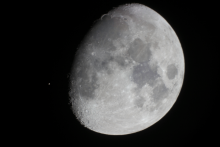Listen to today's episode of StarDate on the web the same day it airs in high-quality streaming audio without any extra ads or announcements. Choose a $8 one-month pass, or listen every day for a year for just $30.
You are here
Moon and Aldebaran
For most of its lifetime, a star wages an internal battle — a battle between radiation and gravity. In the end, though, gravity always wins.
A star that’s nearing the final stages of that battle stands near the Moon tonight. Aldebaran, the brightest star of Taurus, is to the upper left of the Moon at nightfall.
A star is powered by the nuclear fusion reactions in its core. For stars like the Sun, hydrogen atoms are smashed together to make helium.
When the hydrogen is gone, gravity squeezes the core tighter, making it hotter. That allows the helium to fuse to make carbon and oxygen. The hotter core produces more radiation, making the star’s outer layers puff outward. And that’s what’s happening with Aldebaran — it’s puffed up to about 45 times the diameter of the Sun.
When all the helium is gone, though, fusion will stop. Without the radiation pressure, gravity will take over, squeezing Aldebaran’s core tighter and tighter.
It can squeeze only so far, though. Electrons — the negatively charged parts of atoms — exert their own pressure. As a result, there’s a limit to how tightly they can be smashed together. When they reach that limit, they’ll halt the core’s collapse. By then, Aldebaran will have shed its outer layers. So the remaining core will be about half as massive as the Sun, but only about as big as Earth. This ultra-dense corpse is known as a white dwarf — the final result of the battle in the heart of a star.
Script by Damond Benningfield




